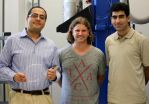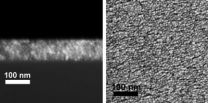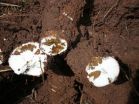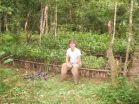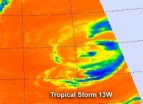(Press-News.org) What a University of Central Florida student thought was a failed experiment has led to a serendipitous discovery hailed by some scientists as a potential game changer for the mass production of nanoparticles.
Soroush Shabahang, a graduate student in CREOL (The College of Optics & Photonics), made the finding that could ultimately change the way pharmaceuticals are produced and delivered.
The discovery was based on using heat to break up long, thin fibers into tiny, proportionally sized seeds, which have the capability to hold multiple types of materials locked in place. The work, published in the July 18 issue of Nature, opens the door to a world of applications.
Craig Arnold, associate professor of Mechanical and Aerospace Engineering at Princeton University and an expert in laser material interactions who did not work on the project, said no one else in the field has been able to accomplish that feat.
With a new non-chemical method of creating identical particles of any size in large quantities, "the possible applications are up to your imagination," Arnold said.
The most immediate prospect is the creation of particles capable of drug delivery that could, for example, combine different agents for fighting a tumor. Or it could combine a time-release component with medications that will only activate once they reach their target – infected cells.
"With this approach you can make a very sophisticated structure with no more effort than creating the simplest of structures," said Ayman Abouraddy, an assistant professor at CREOL and Shabahang's mentor and advisor. Abouraddy has spent his career, first at the Massachusetts Institute of Technology and now at UCF, studying the fabrication of multimaterial fibers.
The technique relies on heat to break molten fibers into spherical droplets. Imagine water dripping from a faucet. Glass fibers are perhaps best known as the cylindrical cables that transmit digital information over long distances. For year, scientists have been looking for ways to improve the purity of glass fibers to allow for faster, disruption-free transmission of light waves.
Shabahang and fellow graduate student Joshua Kaufman were working on just such a project, heating and stretching glass fiber on a homemade tapering machine. Shabahang noticed that instead of the desired result of making the center of the cable thinner, the material actually broke apart into multiple miniature spheres.
"It was kind of a failure to me," Shabahang said.
However, when Abouraddy heard what had happened he knew right away that this "mistake" was a major breakthrough.
While at MIT, Abouraddy and his mentor, Yoel Fink, a professor of materials science and current director of MIT's Research Laboratory of Electronics, said they were told by a theoretician that molten optical fiber should align with a process known as Rayleigh instability, which explains what causes a falling stream of fluid to break into droplets.
At the time, the MIT group was focused on producing fibers containing multiple materials. The team produced fibers by heating a scale model called a "preform" and stretching it apart much the way taffy is made. The process is known as thermal drawing.
Shabahang's experiment shows that by heating and then cooling multimaterial fibers, the theoretical became reality. Uniform particles that look like droplets are produced. Moreover, Shabahang demonstrated that once the spheres form, additional materials can be added and locked into place like LEGO building blocks, resulting in
particles with sophisticated internal structures.
Especially significant is the creation of "beach ball" particles consisting of two different materials melded together in alternating fashion, similar to the stripes on a beach ball.
Kaufman, Shabahang and Abouraddy contributed to the Nature article in addition to Guangming Tao from CREOL, UCF; Esmaeil-Hooman Banaei from the Department of Electrical Engineering & Computer Science, UCF; Daosheng S. Deng, Department of Chemical Engineering, MIT; Xiangdong Liang, Department of Mathematics, MIT; Steven G. Johnson, Department of Mathematics, MIT; and Yoel Fink from MIT.
INFORMATION:
Some of the funding for the project was made available by the National Science Foundation, the Oak Ridge Associated Universities through a Ralph E. Powe Junior Faculty Enhancement Award, and the Air Force Office of Scientific Research.
The Nature paper is available here:
http://www.nature.com/nature/journal/vaop/ncurrent/full/nature11215.html
UCF nanoparticle discovery opens door for pharmaceuticals
2012-08-08
ELSE PRESS RELEASES FROM THIS DATE:
New drug successfully halts fibrosis in animal model of liver disease
2012-08-08
A study published in the online journal Hepatology reports a potential new NADPH oxidase (NOX) inhibitor therapy for liver fibrosis, a scarring process associated with chronic liver disease that can lead to loss of liver function.
"While numerous studies have now demonstrated that advanced liver fibrosis in patients and in experimental rodent models is reversible, there is currently no effective therapy for patients," said principal investigator David A. Brenner, MD, vice chancellor for Health Sciences and dean of the School of Medicine at the University of California, ...
Chemists advance clear conductive thin films
2012-08-08
PROVIDENCE, R.I. [Brown University] — In a touch-screen display or a solar panel, any conductive overlay had better be clear. Engineers employ transparent thin films of indium tin oxide (ITO) for the job, but a high-tech material's properties are only half its resume. They must also be as cheap and easy to manufacture as possible. In a new study, researchers from Brown University and ATMI Inc. report the best-ever transparency and conductivity performance for an ITO made using a chemical solution, which is potentially the facile, low-cost method manufacturers want.
"Our ...
Diseased trees new source of climate gas
2012-08-08
Diseased trees in forests may be a significant new source of methane that causes climate change, according to researchers at the Yale School of Forestry & Environmental Studies in Geophysical Research Letters.
Sixty trees sampled at Yale Myers Forest in northeastern Connecticut contained concentrations of methane that were as high as 80,000 times ambient levels. Normal air concentrations are less than 2 parts per million, but the Yale researchers found average levels of 15,000 parts per million inside trees.
"These are flammable concentrations," said Kristofer Covey, ...
Researchers demonstrate control of devastating cassava virus in Africa
2012-08-08
ST. LOUIS, MO, August 7, 2012— An international research collaboration recently demonstrated progress in protecting cassava against cassava brown streak disease (CBSD), a serious virus disease, in a confined field trial in Uganda using an RNA interference technology. The field trial was planted in November 2010 following approval by the National Biosafety Committee of Uganda. The plants were harvested in November 2011 and results were published in the August 1, 2012 issue of the journal Molecular Plant Pathology . These results point researchers in the right direction ...
GEN reports on recent progress in Alzheimer's research
2012-08-08
New Rochelle, NY, August 7, 2012—The global market value of Alzheimer's disease therapeutics could soar to the $8 billion range once therapeutics are approved that actually change the course of the disease, reports Genetic Engineering & Biotechnology News (GEN). The current therapeutic market is valued at $3 to $4 billion, shared among drugs that temporarily delay disease progression or address the symptoms but do not alter the underlying disease, according to a recent issue of GEN.
"Despite all the research on amyloid plaques and neurofibrillary tangles there is still ...
Notre Dame researcher is shedding light on how jaws evolve
2012-08-08
If you're looking for information on the evolution and function of jaws, University of Notre Dame researcher Matt Ravosa is your man.
His integrative research program investigates major adaptive and morphological transformations in the mammalian musculoskeletal system during development and across higher-level groups. In mammals, the greater diversification and increasingly central role of the chewing complex in food procurement and processing has drawn considerable attention to the biomechanics and evolution of this system. Being among the most highly mineralized, and ...
Can nature parks save biodiversity?
2012-08-08
The 14 years of wildlife studies in and around Madagascar's Ranomafana National Park by Sarah Karpanty, associate professor of wildlife conservation at Virginia Tech's College of Natural Resources and Environment, and her students are summarily part of a paper on biodiversity published July 25 by Nature's Advanced Online Publication and coming out soon in print.
As human activities put increasing pressures on natural systems and wildlife to survive, 200 scientists around the world carved up pieces of the puzzle to present a clearer picture of reality and find ways to mitigate ...
Planting the seeds of defense
2012-08-08
LA JOLLA, CA----It was long thought that methylation, a crucial part of normal organism development, was a static modification of DNA that could not be altered by environmental conditions. New findings by researchers at the Salk Institute for Biological Studies, however, suggest that the DNA of organisms exposed to stress undergo changes in DNA methylation patterns that alter how genes are regulated.
The scientists found that exposure to a pathogenic bacteria caused widespread changes in a plant's epigenetic code, an extra layer of biochemical instructions in DNA that ...
Increasing federal match funds for states boosts enrollment of kids in health-care programs
2012-08-08
Ann Arbor, Mich. — Significantly more children get health insurance coverage after increases in federal matching funds to states for Medicaid and the Children's Health Insurance Program (CHIP), according to new research from the University of Michigan.
The research, published Monday in the journal Health Affairs, showed that a 10-percentage-point increase in the federal match for Medicaid and CHIP, similar to the increase that occurred with the American Reinvestment and Recovery Act, is associated with an increase of 1.9 percent in the number of children enrolled in ...
Infrared NASA imagery shows a weaker Tropical Storm 13W
2012-08-08
Infrared satellite imagery from shows how cold cloud top temperatures are in a tropical cyclone, and recent imagery from NASA's Aqua satellite shows the cloud-top temperatures have been warming in Tropical Storm 13W. Warming cloud top temperatures indicate less strength, and Tropical Storm 13W is weakening.
NASA's Aqua satellite passed over Tropical Storm 13W on August 7 at 0253 UTC. The Atmospheric Infrared Sounder (AIRS) instrument that flies onboard Aqua captured an infrared image of the storm's cloud temperatures that showed very limited strong thunderstorms make ...
